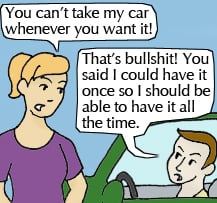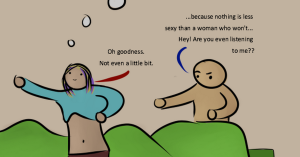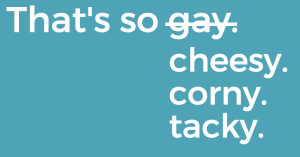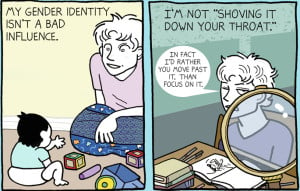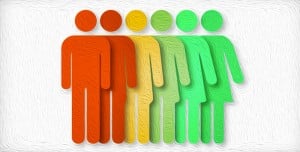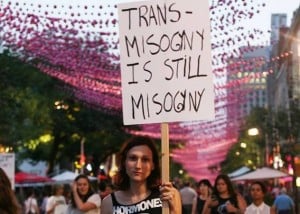
A person in a crowd holds a sign reading “transmisogyny is still misogyny.” Source: Salty Sojourn
Let’s talk about transmisogyny.
This word describes so much of what we see in the cultural and systemic treatment of trans women in our culture and ties in so clearly with feminism, and yet it’s not a word that many people know about or understand.
You may have heard of transphobia: the discrimination of and negative attitudes toward transgender people based on their gender expression.
And you’ve likely heard of misogyny: the hatred and denigration of women and characteristics deemed feminine.
Transmisogyny, then, is the confluence of these – the negative attitudes, expressed through cultural hate, individual and state violence, and discrimination directed toward trans women and trans and gender non-conforming people on the feminine end of the gender spectrum.
Who Is Vicitimized by Transmisogyny?
Transmisogyny targets transgender and transsexual women – people who were assigned male at birth, but who identify as women.
But transgender women are not the only people who experience transmisogyny.
Trans and gender non-conforming people who do not necessarily identify as women, but who present feminine characteristics and/or identify along the feminine end of the gender spectrum are also on the receiving end of transmisogyny.
Transmisogyny is all about the hatred of the feminine, and it is not limited toward only those who identify as women. It includes transfeminine and feminine-identified genderqueer people, as well as many others who are feminine-of-center but were not assigned female at birth.
So for the purpose of simplicity and brevity in this article, I will use the term trans women to refer to all people victimized by transmigogyny.
Why Does Transmisogyny Exist?
Transmisogyny is based in the assumption that femininity is inferior to masculinity.
It relies on an understanding of all those qualities that are associated with ”femaleness” and devaluing them, viewing them as less than those qualities associated with “maleness” and therefore as deserving of hatred, mockery, and violence.
This sounds a whole lot like sexism, doesn’t it?
Why should there be a specific word used to describe the experience of trans people who are specifically feminine? How is this different from sexism and transphobia?
Trans women experience a particular kind of sexist marginalization based in their unique position of overlapping oppressions – they are both trans and feminine. They are devalued by society on both accounts.
Trans people experience transphobia, or cissexism, due to a cultural and systemic obsession with the gender binary: the idea that there are two types of people – men and women – who are born, raised, and naturally associate with that gender and its accompanying characteristics. Our cultural and political institutions are based on this premise.
Transmisogyny reflects a hatred of those who do not fit easily into either side of the gender binary.
Trans women are not always easily categorized, and for people and institutions whose understanding of gender relies deeply in the repressive gender binary, this is confusing, transgressive, and for some, worthy of hate.
The response to the existence of those who challenge the social understanding of gender, then, is extreme oppression and marginalization of trans people of all gender expressions.
Trans-Femininity and Sexism
Our society is steeped in the notion that women and characteristics coded as feminine are inferior to men and those qualities coded as masculine.
In our sexist society, being a woman automatically places you in a position of less value.
But to give up one’s “important” position as a man, choosing (as trans people are perceived to do) to be a woman and to be feminine, in a way, poses a fundamental threat to male superiority and may be seen as a rejection of the “superior male identity.”
Trans women are not only a reminder to society that gender categories are not fixed, but also that womanhood and feminine gender expression is not something to be ashamed of.
In this way, understanding transmisogyny is absolutely imperative to our work as feminists, and makes clear just how integral trans issues and rights are to our work around gender.
Not only is transmisogyny steeped in sexism, but the resulting oppression is parallel to what cisgender (those who identify with the gender of which they were assigned at birth) women face: physical objectification, over-sexualization, stereotyping, policing of bodies, a discrimination on all levels of society, and individual and systemic acts of violence.
The Violence of Transmisogyny
Transmisogyny rears its ugly head in many ways and on all levels of society.
We see it, for instance, in violence on an individual level.
Hate crimes against trans people are disproportionately and tragically high, and the majority of this violence victimizes trans women.
In fact, over half of all anti-LGBTQIA+ homicides were perpetrated against transgender women. And while we’re talking statistics, it’s important to note that nearly three-quarters of those homicides targeted people of Color.
We see transmisogyny in state violence as well.
1 in 5 transgender women (21%) has been incarcerated at some point in her life. This is far above the general population, and is even higher (47%) for Black transgender people.
According to the National Center for Transgender Equality, trans people experience disproportionately high rates of poverty and homelessness caused by discrimination in jobs and housing, but they also experience greater incarceration rates, largely due to gender profiling by the police.
Gender is policed, quite literally by police officers who target, arrest, and often harass trans women for looking “different” and therefore, “disorderly.” Trans women of Color, in particular, tend to be perceived by police through racialized and gender stereotypes framing them as highly sexual and as criminal.
Trans women are consistently targeted and arrested for being involved in sex work, even if they have no association with this work.
There have been many instances where trans women, most often trans women of Color, have been arrested for carrying condoms.
In New York, where having a condom on you can be used as evidence of involvement in sex work, trans women are being profiled, searched, and arrested for being a trans woman at the wrong place at the wrong time.
There’s also direct violence at the hands of police: A 2012 study by the National Coalition of Anti-Violence Programs found that transgender people across the U.S. experience three times more police violence than cisgender people.
And nearly half of trans people who reported hate crimes to the police experienced mistreatment from them while asking for help.
Trans women experience abuse after being arrested as well, when they are most often forced to reside in men’s prison facilities, experiencing extremely high rates of sexual and physical violence – a study by the Department of Justice found that 1 in 3 are sexual assaulted in prison. In response, many prisons place trans women in solitary confinement for extended periods of time “for their own protection.” (Meanwhile, solitary confinement is considered a form of torture.)
In the Media
While trans men are generally ignored and made invisible by American media, trans women are exoticized, their existence perceived as shocking and newsworthy. They are mocked, over-sexualized, and fetishized.
Trans women are given an extremely two-dimensional portrayal in the news, where they are most often reported on in association of a hate crime. In these reports, their gender is consistently portrayed as confusing and illegitimate, appearing in countless headlines like this one: “Man Dressed as Woman Found Dead.
Our media portrays trans women in archetypes – as the weak victim of a crime, or as the evil villain; as the mentally unstable character, or as the manipulative one.
They are often pathologized and sexualized, portrayed as someone manipulatively hiding their transgender identity to trick a man into engaging with them sexually or romantically.
They play countless television roles as sex workers.
They are shown as unattractive; they are the butt of jokes, their desire to be feminine mocked, their motives for transitioning questioned.
And while it is difficult to find complex and honest portrayals of trans women characters on television, it is even more rare to find an authentic and respectful portrayal of a trans woman of Color (though we have see a few recently, like the great Laverne Cox in Orange is the New Black).
In Queer and Women’s Spaces
Sadly, transmisogyny is also very present in LGBTQIA+ spaces, where trans women, particularly trans women of Color, are marginalized within an already marginalized group.
The mainstream LGBTQIA+ movement has been called out many times for excluding trans people, and there is a pervasive sexism in the movement as well as in social spaces, that promotes transmisogyny and a denigration of feminine qualities.
Masculine privilege, like white privilege, does not disappear once one is in a queer space. So when trans women share their experiences, queer cis male leaders have too many times dismissed them and accused them of “hurting the LGBTQ movement” due to the visible transgression of many of society’s norms involved in being a trans woman.
And although it should be the last place where transmisogyny is present, sadly, we see it often in cis women’s spaces.
Trans women are excluded from many domestic violence shelters and other crisis spaces that exist in response to violence against women in our society.
Trans women continue to be excluded from many women-only spaces and feminist events, while some “feminists” continue to speak out against the very existence of trans women, arguing that they are not “authentic” women and that they are “hurting the movement.”
Trans women have called these groups and spaces out, creating inclusive spaces in the meantime, citing that they experience sexism and homophobia in very real and concrete ways, and yet are excluded from the spaces which were created in response to these oppressions.
What Can We Do?
Transmisogyny, like sexism, is pervasive and structural, but it also exists in our everyday experiences. Once you understand it, you begin to notice it in personal interactions, on television, and in social movements and political campaigns.
Call it out! Name it for what it is. Transmisogyny, like, sexism, goes unnoticed too often because it is so entrenched in our sociocultural and political understanding of gender. Educate others about this issue.
And most importantly, don’t be afraid to call out other feminists or gay rights advocates for transmisoginistic words and actions. These are the spaces we need to make more inclusive.
It is so important that we work together to find a solution to the problem of transmisogyny’s existence in our movements and that we always act in solidarity with our trans sisters.
If our movements seek to eradicate transphobia, homophobia, and sexism, then we must address transmisogyny, located at the intersection of these oppressions, and make it a priority in our fight.
[do_widget id=”text-101″]
Laura Kacere is a Contributing Writer for Everyday Feminism and is an feminist activist, social justice organizer, clinic escort, and yogi living in Washington, D.C. Laura coordinates the Washington Area Clinic Defense Task Force, teaches yoga with the intent of making it accessible to all, and does outreach for the DC-based sex worker support organization, HIPS. When she isn’t on her mat or at the clinic, she’s usually thinking about zombies, playing violin, eating Lebanese food, and wishing she had a cat. Follow her on Twitter @Feminist_Oryx. Read her articles here.
Search our 3000+ articles!
Read our articles about:
Our online racial justice training
Used by hundreds of universities, non-profits, and businesses.
Click to learn more






